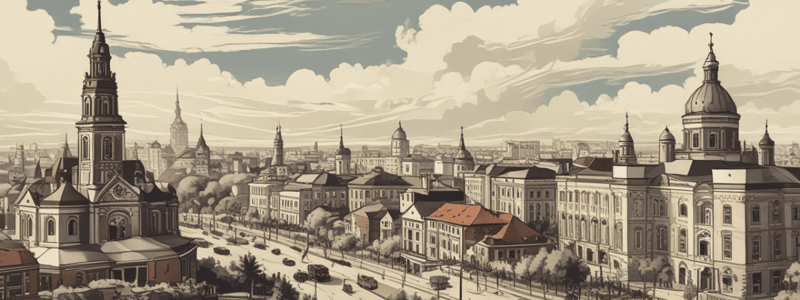Podcast
Questions and Answers
В каком году был основан город Минск?
В каком году был основан город Минск?
- 1922
- 1919
- 1101
- 1067 (correct)
Столицей какой страны являлся Минск в 1919 году?
Столицей какой страны являлся Минск в 1919 году?
- России
- Литвы
- Польши
- Белорусской ССР (correct)
Какое событие привело к установлению гетто в Минске во время Второй мировой войны?
Какое событие привело к установлению гетто в Минске во время Второй мировой войны?
- Создание советских фабрик
- Немецкое вторжение (correct)
- Уход советских войск
- Строительство музеев
Какие изменения произошли в Минске после эпохи Советов?
Какие изменения произошли в Минске после эпохи Советов?
Что было результатом программы реконструкции и развития, начавшейся в Минске в 1922 году?
Что было результатом программы реконструкции и развития, начавшейся в Минске в 1922 году?
Что из перечисленного не упоминается в тексте как культурное учреждение современного Минска?
Что из перечисленного не упоминается в тексте как культурное учреждение современного Минска?
Что из перечисленного не относится к историческим зданиям и памятникам Минска, упомянутым в тексте?
Что из перечисленного не относится к историческим зданиям и памятникам Минска, упомянутым в тексте?
Какое событие сыграло значительную роль в развитии белорусского языка и культуры в Минске в 1920-х и 1930-х годах?
Какое событие сыграло значительную роль в развитии белорусского языка и культуры в Минске в 1920-х и 1930-х годах?
Чем известен современный Минск, согласно тексту?
Чем известен современный Минск, согласно тексту?
Какое из следующих утверждений верно относительно роли Минска во время Второй мировой войны?
Какое из следующих утверждений верно относительно роли Минска во время Второй мировой войны?
Flashcards are hidden until you start studying
Study Notes
The History of Minsk
Founding of Minsk
Minsk is the capital city of Belarus and serves as the country's administrative center. It is situated in the central part of Belarus, lying on gently hilly terrain along the Svisloch River, which flows southeast through the region. The city's earliest recorded mention dates back to the year 1067, making it over a thousand years old. Minsk initially began as a Slavic village and later became the seat of a principality in 1101. Over the centuries, Minsk passed through various hands, including Lithuania, Poland, and Russia, before becoming the capital of the Belorussian Soviet Socialist Republic (SSR) in 1919.
Minsk during World War II
During the Second World War, Minsk faced extensive devastation. At the start of the war, at least one-third of the city's population were Jewish, and the German army overran Minsk in 1941, leading to the establishment of a ghetto. Living conditions in the ghetto were miserable, and the Jewish community faced widespread persecution and eventual massacres. Soviet forces retook the city in 1944, but the fighting left Minsk almost completely destroyed, with the historical center replaced by Stalinist architecture.
Soviet Era in Minsk
Following the Soviet era, Minsk underwent significant changes. A program of reconstruction and development began in 1922, leading to the establishment of factories, schools, museums, theaters, and libraries. Throughout the 1920s and 1930s, Minsk experienced rapid development, with dozens of new factories being built and new educational and cultural institutions being opened. During this period, Minsk also played a role in the development of Belarusian language and culture.
Modern History of Minsk
Modern Minsk is a bustling city with a population of approximately 2,009,786 as of 2021. It is the major industrial center of Belarus, with a focus on machine building, particularly the manufacture of trucks and tractors. The city is also a major educational, cultural, and printing center, with institutions such as the National Academy of Sciences of Belarus, Belarus State University, and numerous other institutions of higher education. Minsk has a music conservatory, a palace of winter sports, and a number of theaters, including the Belarus State Theatre of Opera and Ballet.
Cultural Developments in Minsk
Cultural developments in Minsk have played a significant role in the city's growth and identity. The city has a rich history, with a number of historical buildings and landmarks surviving from before 1900, including the Holy Spirit Cathedral, the Church of Saints Peter and Paul, and the church of the Bernardine monastery. Minsk is also home to several museums of art and history, including the Great Patriotic War (World War II) Museum. In addition to these historical sites, Minsk has a thriving cultural scene, with a variety of theaters, galleries, and other cultural institutions.
In conclusion, Minsk has a rich and complex history, with a long-standing tradition of cultural and educational development. Despite facing numerous challenges and hardships, the city has continued to thrive and grow, becoming a major center of industry, culture, and learning in Belarus and beyond.
Studying That Suits You
Use AI to generate personalized quizzes and flashcards to suit your learning preferences.




